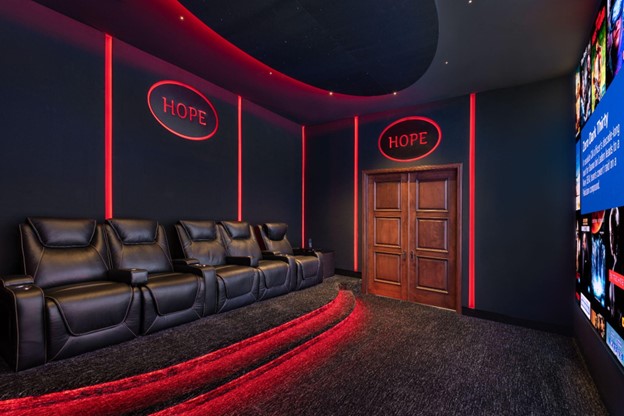Home Theater 101: Everything You Required to Know for a Motion Picture Experience at Home
Creating a home theater that rivals the cinematic experience of an industrial theatre includes careful consideration of several elements, including screen option, sound systems, and area format. Whether you are considering the ideal screen size or the intricacies of border audio, recognizing these principles is necessary.
Selecting the Right Screen
When establishing up a home movie theater, choosing the right screen can make or damage the checking out experience - home theater design tampa. The display serves as the centerpiece of your arrangement, influencing photo high quality, seeing angles, and overall aesthetic. Trick aspects to think about include display resolution, dimension, and type
First, figure out the proper display dimension based on your space measurements and seating range. Next off, choose in between various screen kinds, such as fixed-frame, motorized, or retracting displays, each offering distinct advantages.
Resolution is an additional vital factor. For a genuinely immersive experience, consider a screen created for 4K or perhaps 8K content, making certain sharpness and clearness. In addition, consider the screen's gain, which impacts illumination and comparison; a greater gain can enhance brightness in well-lit spaces, while a reduced gain might be better for darker settings.
Picking Audio Equipment
Audio equipment is an important part of any kind of home theater system, substantially boosting the total viewing experience. The selection of audio gear can identify the depth, clearness, and immersion of noise, critical for creating a cinematic atmosphere.
When selecting audio devices, think about a surround audio system, which typically consists of a receiver, several audio speakers, and a subwoofer. A 5.1 or 7.1 network system is suggested, where the very first number represents the audio speakers and the second the subwoofer, providing an immersive soundscape. The receiver is the heart of the system, managing sound and video signals, and should support contemporary formats like Dolby Atmos for an enhanced spatial experience.
Quality audio speakers are important; appearance for designs that supply a well balanced audio profile with good bass reaction. Floor-standing audio speakers can generate richer noise, while shelf alternatives conserve space. Additionally, think about wireless choices for convenience of setup, although wired systems typically supply superior efficiency.

Optimum Seating Arrangements
Producing an excellent home cinema experience hinges considerably on optimal seating setups. The setup of seats plays a vital role in both comfort and watching quality, straight impacting the overall motion picture experience.
First, consider the display size and viewing distance. A typical standard is to position seats at a range roughly 1.5 to 2.5 times the angled size of the display. This guarantees an immersive experience without straining the eyes.
Next, altitude is essential. The back rows must be higher than the front to prevent blockages if your seating is in a tiered format. For flat seating, ensure that the front row is not too near to the display, and that every person has a clear line of sight.
In addition, take into consideration the plan in regards to social dynamics. Team seats can improve the common experience, while private seats may be chosen for individual watching.

Last but not least, focus on convenience with ergonomic seats that supports extended watching durations. Integrating recliners or supported seats can significantly enhance the experience, making the home theater a favored location for both entertainment and relaxation.
Lighting and Atmosphere
Efficient illumination and ambiance click this link are essential parts of a properly designed home theater, as they dramatically influence the seeing experience. The best lighting can improve the motion picture feeling, while bad choices can diminish it. For optimum results, take into consideration a split illumination technique that includes ambient, task, and accent lighting.
Ambient illumination gives basic illumination, making certain that the area is not totally dark, which can stress the eyes. Dimmer buttons are extremely suggested, permitting for adjustments based on the content being viewed. Task lighting, such as wall sconces or floor lamps, offers practical lighting for activities like analysis or navigating the space without interfering with the overall atmosphere.
Accent illumination can be used to highlight click over here architectural functions or develop prime focus, including deepness and rate of interest to the area. LED strip lights behind displays or along racks can provide a refined radiance that improves the aesthetic experience without frustrating the customer.
Wiring and Installation Tips
A well-planned circuitry setup is critical for attaining ideal performance in your house movie theater system. Appropriate electrical wiring not just ensures top notch audio and video clip signals yet additionally improves the general aesthetic of your room. Begin by mapping out your layout, recognizing where each element will be positioned, including your screen, audio speakers, and receiver.
When choosing cable televisions, focus on high-grade, properly evaluated circuitry to minimize signal loss. HDMI cables need to be utilized for video clip connections, while audio speaker cable should match the requirements of your speakers and amplifier. Select in-wall rated wires to follow safety criteria and maintain a tidy look.

Final Thought
In recap, developing an exceptional home theater experience needs cautious factor to consider of different components, consisting of display option, audio tools, seating arrangements, lighting, and wiring. By prioritizing these elements, a cinematic atmosphere can be effectively duplicated, enabling for immersive seeing experiences that match conventional movie theater settings.
Creating a home theater that matches the cinematic experience of a commercial theatre entails mindful consideration of several components, consisting of display selection, audio systems, and room layout.When establishing up a home cinema, picking the ideal screen can make or break the seeing experience. Next, choose in between different screen types, such as fixed-frame, mechanized, or retracting screens, each offering distinct benefits. For an absolutely immersive experience, think about a screen developed for 4K or even 8K web content, ensuring intensity and clearness.In summary, developing an extraordinary home theater experience calls for cautious consideration of numerous aspects, including display choice, audio equipment, seating setups, lighting, and circuitry.